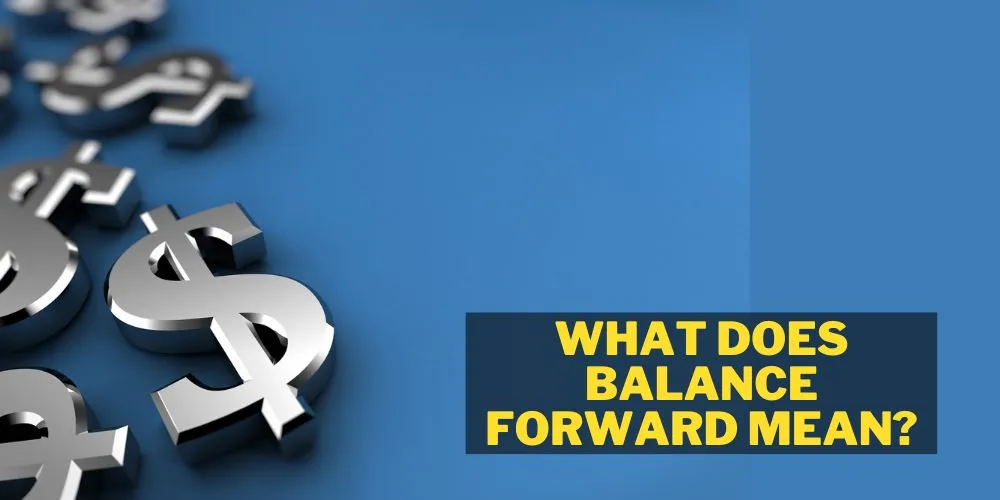The concept of a balance forward is crucial in both personal finance and business accounting. It represents an amount brought from previous billing periods into current financial statements, such as credit card or utility bills.
This article explores what does balance forward mean, how it functions, and its implications for financial management.
Understanding Balance Forward
Definition
Balance forward refers to the amount carried over from one billing period to the next. It is not to be confused with similar terms such as “brought forward.”
In essence, balance forward is the starting amount on a new invoice or statement, originating from the unresolved balance of previous periods.
How It Works
To understand how balance forward works, consider a simple example. If you end a billing period on your credit card with an unpaid balance of $200 and you do not pay it off before the next statement, that $200 becomes the balance forward on the new statement.
Subsequent purchases, fees, or payments will adjust this starting balance, resulting in a new balance at the end of the current period.
What Does Balance Forward Mean?
Opening Balance
The opening balance, in the context of balance forward, is the amount from the previous period that remains unpaid and is carried over to the current statement.
Ensuring this balance is recorded accurately is vital for maintaining correct financial records.
Transactions During the Period
Throughout a billing period, various transactions can affect the balance forward. These may include payments that reduce the balance, new charges that increase it, and credits or adjustments.
Each transaction influences the balance forward and dictates what the closing balance will be at the period’s end.
Closing Balance
At the end of the billing cycle, all transactions are summed to determine the closing balance. This amount then becomes the balance forward for the next billing period.
This cycle ensures continuity in financial tracking and helps prevent losses or discrepancies in record-keeping.
The Role of Balance Forward in Financial Management
Budgeting and Forecasting
Understanding and monitoring your balance forward can significantly enhance budgeting strategies and financial forecasting. It provides a clear picture of ongoing liabilities and can help plan future expenditures or savings strategies more effectively.

Debt Management
For those managing debt, keeping a close eye on the balance forward is crucial.
It shows how much debt is being carried over each period, helping to gauge the effectiveness of debt repayment strategies and adjust them as necessary.
Pros and Cons of Balance Forward Accounting
Pros
The main advantage of using balance forward accounting is its simplicity. It provides a straightforward method for tracking carryover amounts from one period to another, facilitating clear and consistent financial records.
Moreover, it helps in maintaining a continuous overview of financial obligations.
Cons
On the downside, balance forward accounting can lead to potential issues if not monitored carefully. Errors in one period can carry over to the next, compounding over time if not corrected swiftly.
This might lead to a distorted financial view and affect financial decision-making.
How to Manage and Track Your Balance Forward
Best Practices
To manage balance forward effectively, it is advisable to regularly review and reconcile your financial statements.

Using software tools or applications designed for financial management can help track your balance forward and other important financial indicators efficiently. Ensuring that all transactions are recorded accurately and in a timely manner is crucial.
Pro Tips
Setting regular check-ins with your financial statements will help you stay informed about your balance forward and manage your finances more effectively.
Consider setting up automated payments to manage outstanding balances and control debt growth efficiently.
Case Studies
Effective Management: Costco
Background: Costco utilizes a balance forward system for its business members, streamlining monthly invoicing.
Outcome: This has led to improved cash flow and member satisfaction.
Lesson: A well-managed balance forward system enhances customer convenience and business efficiency.
Poor Management: Boutique Hotel Chain
Background: A boutique hotel chain poorly implemented a balance forward system, leading to billing inaccuracies.
Outcome: It resulted in customer dissatisfaction and lost revenue.
Lesson: Accuracy and transparency are crucial in balance forward systems to maintain trust and loyalty.
Frequently Asked Questions
Is balance forward the same as carrying forward?
Balance forward and carrying forward generally refer to the same concept in financial management, representing amounts transferred from one period to the next.
How does balance forward affect my credit rating?
A persistent balance forward, especially on credit accounts, might indicate ongoing debt which could impact your credit score. Maintaining lower balances and regular payments can help improve your credit rating.
Can I dispute a balance forward amount?
If you believe your balance forward is incorrect, review your previous statements for discrepancies. You should contact the issuer or service provider to rectify errors or understand adjustments.
Does every invoice include a balance forward?
Not all invoices will show a balance forward. It appears only when there are unpaid balances from previous periods.
Conclusion
Balance forward is a fundamental concept in financial management, crucial for both individuals and businesses. By understanding and regularly reviewing this figure, you can maintain better control over your financial health and make more informed financial decisions.


 Tags:
Tags:










